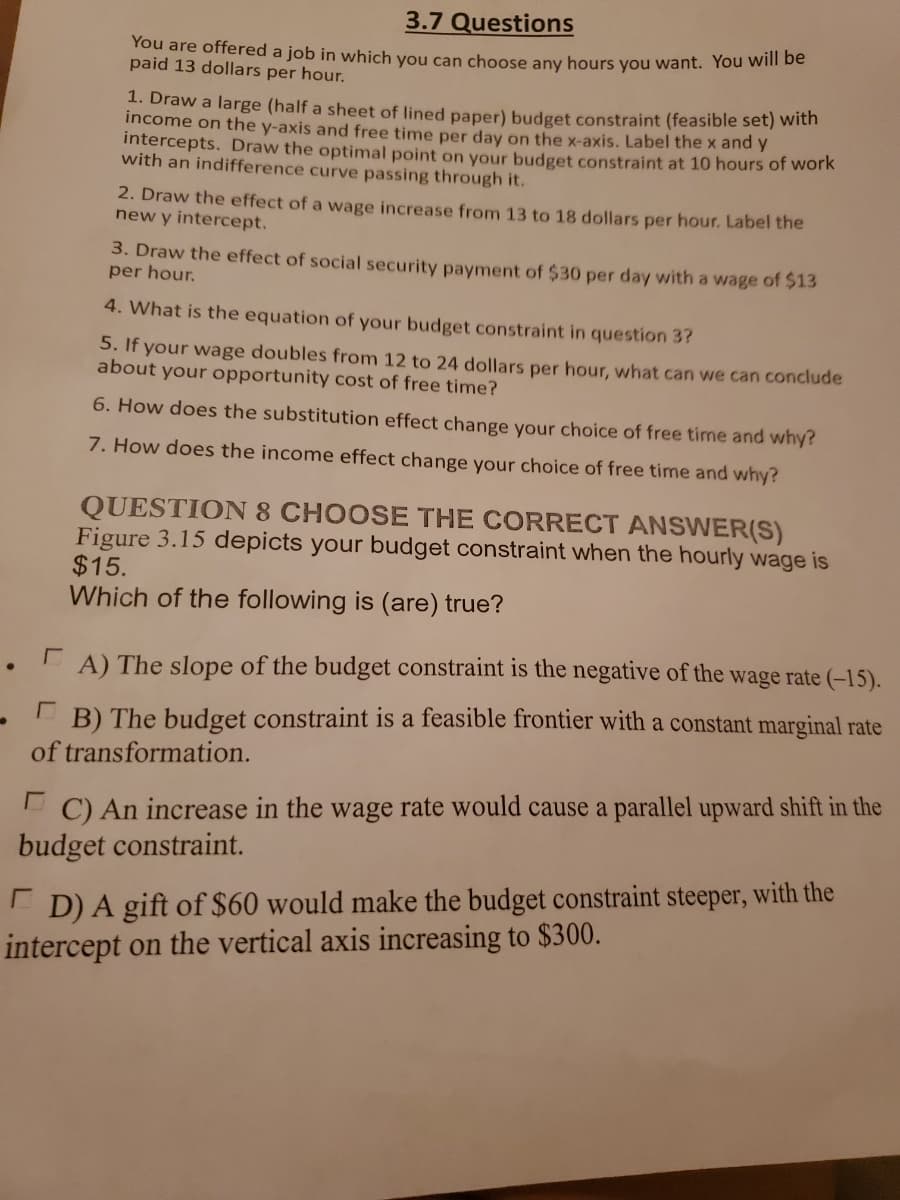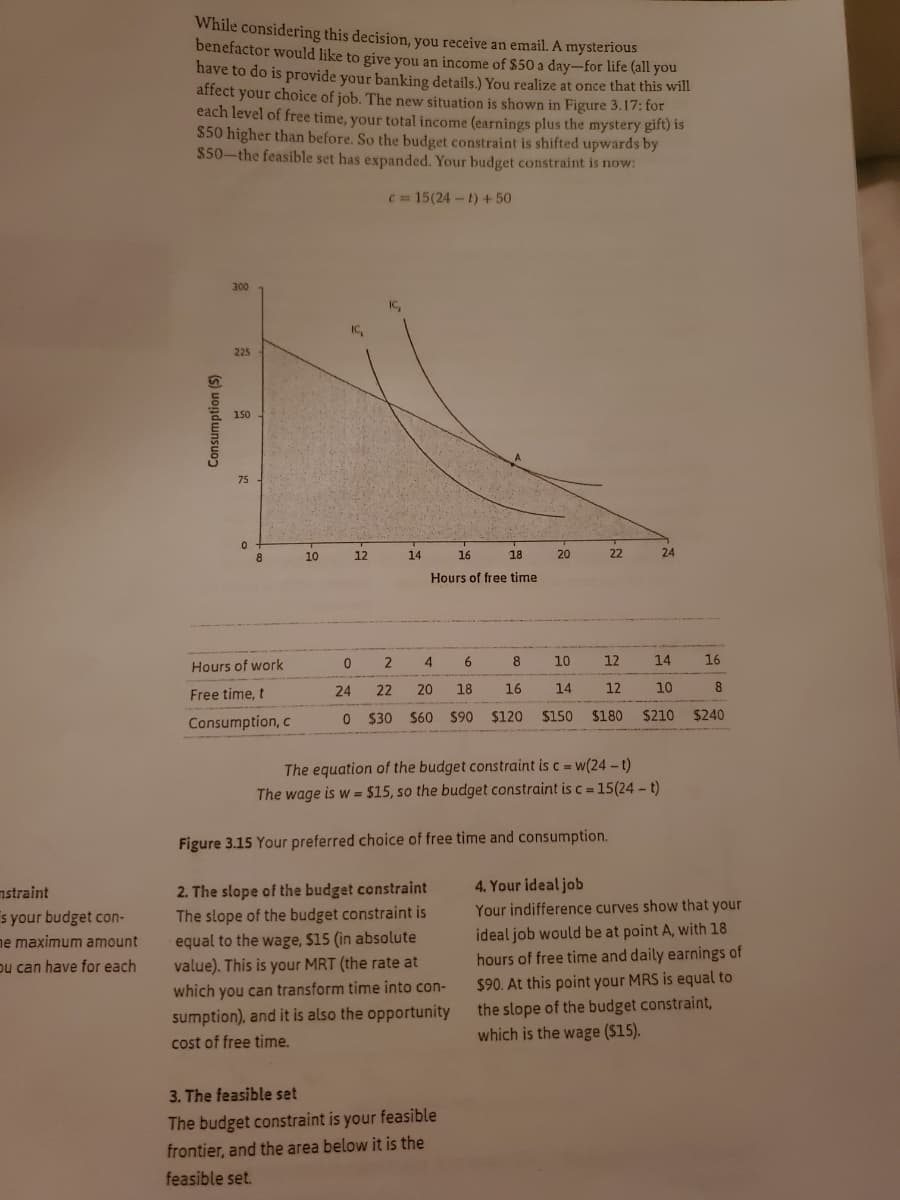QUESTION 8 CHOOSE THE CORRECT ANSWER(S) Figure 3.15 depicts your budget constraint when the hourly wage is $15. Which of the following is (are) true? E A) The slope of the budget constraint is the negative of the wage rate (–15). C B) The budget constraint is a feasible frontier with a constant marginal rate of transformation. C) An increase in the wage rate would cause a parallel upward shift in the budget constraint. I D) A gift of $60 would make the budget constraint steeper, with the intercept on the vertical axis increasing to $300.
QUESTION 8 CHOOSE THE CORRECT ANSWER(S) Figure 3.15 depicts your budget constraint when the hourly wage is $15. Which of the following is (are) true? E A) The slope of the budget constraint is the negative of the wage rate (–15). C B) The budget constraint is a feasible frontier with a constant marginal rate of transformation. C) An increase in the wage rate would cause a parallel upward shift in the budget constraint. I D) A gift of $60 would make the budget constraint steeper, with the intercept on the vertical axis increasing to $300.
Chapter1: Making Economics Decisions
Section: Chapter Questions
Problem 1QTC
Related questions
Question
100%

Transcribed Image Text:3.7 Questions
You are offered a job in which you can choose any hours you want. You wih b
paid 13 dollars per hour.
1. Draw a large (half a sheet of lined paper) budget constraint (feasible set) with
income on the y-axis and free time per day on the x-axis. Label the x and y
intercepts. Draw the optimal point on your budget constraint at 10 hours of work
with an indifference curve passing through it.
2. Draw the effect of a wage increase from 13 to 18 dollars per hour. Label the
new y intercept.
3. Draw the effect of social security payment of $30 per day with a wage of $13
per hour.
4. What is the equation of your budget constraint in question 3?
5. If your wage doubles from 12 to 24 dollars per hour, what can we can conclude
about your opportunity cost of free time?
6. How does the substitution effect change your choice of free time and why?
7. How does the income effect change your choice of free time and why?
QUESTION 8 CHOOSE THE CORRECT ANSWER(S)
Figure 3.15 depicts your budget constraint when the hourly wage is
$15.
Which of the following is (are) true?
E A) The slope of the budget constraint is the negative of the wage rate (-15).
B) The budget constraint is a feasible frontier with a constant marginal rate
of transformation.
C) An increase in the wage rate would cause a parallel upward shift in the
budget constraint.
I D) A gift of $60 would make the budget constraint steeper, with the
intercept on the vertical axis increasing to $300.

Transcribed Image Text:While considering this decision, you receive an email. A mysterious
benefactor would like to give you an income of $50 a day-for life (all you
have to do is provide your banking details.) You realize at once that this will
affect your choice of job. The new situation is shown in Figure 3.17: for
each level of free time, your total income (earnings plus the mystery gift) is
$50 higher than before. So the budget constraint is shifted upwards by
$50-the feasible set has expanded. Your budget constraint is now:
c = 15(24 - t) + 50
300
IC,
225
150
75
8.
10
12
14
16
18
20
22
24
Hours of free time
Hours of work
2
4
6
8
10
12
14
16
Free time, t
24
22
20
18
16
14
12
10
Consumption, c
0 $30 $60 $90
$120
$150 $180
$210
$240
The equation of the budget constraint is c = w(24 - t)
The wage is w = $15, so the budget constraint is c = 15(24 – t)
Figure 3.15 Your preferred choice of free time and consumption.
4. Your ideal job
2. The slope of the budget constraint
The slope of the budget constraint is
nstraint
Your indifference curves show that your
s your budget con-
ne maximum amount
pu can have for each
ideal job would be at point A, with 18
equal to the wage, $15 (in absolute
value). This is your MRT (the rate at
hours of free time and daily earnings of
which you can transform time into con-
$90. At this point your MRS is equal to
sumption), and it is also the opportunity
cost of free time.
the slope of the budget constraint,
which is the wage ($15).
3. The feasible set
The budget constraint is your feasible
frontier, and the area below it is the
feasible set.
Consumption ($)
Expert Solution
This question has been solved!
Explore an expertly crafted, step-by-step solution for a thorough understanding of key concepts.
This is a popular solution!
Trending now
This is a popular solution!
Step by step
Solved in 2 steps

Knowledge Booster
Learn more about
Need a deep-dive on the concept behind this application? Look no further. Learn more about this topic, economics and related others by exploring similar questions and additional content below.Recommended textbooks for you


Principles of Economics (12th Edition)
Economics
ISBN:
9780134078779
Author:
Karl E. Case, Ray C. Fair, Sharon E. Oster
Publisher:
PEARSON

Engineering Economy (17th Edition)
Economics
ISBN:
9780134870069
Author:
William G. Sullivan, Elin M. Wicks, C. Patrick Koelling
Publisher:
PEARSON


Principles of Economics (12th Edition)
Economics
ISBN:
9780134078779
Author:
Karl E. Case, Ray C. Fair, Sharon E. Oster
Publisher:
PEARSON

Engineering Economy (17th Edition)
Economics
ISBN:
9780134870069
Author:
William G. Sullivan, Elin M. Wicks, C. Patrick Koelling
Publisher:
PEARSON

Principles of Economics (MindTap Course List)
Economics
ISBN:
9781305585126
Author:
N. Gregory Mankiw
Publisher:
Cengage Learning

Managerial Economics: A Problem Solving Approach
Economics
ISBN:
9781337106665
Author:
Luke M. Froeb, Brian T. McCann, Michael R. Ward, Mike Shor
Publisher:
Cengage Learning

Managerial Economics & Business Strategy (Mcgraw-…
Economics
ISBN:
9781259290619
Author:
Michael Baye, Jeff Prince
Publisher:
McGraw-Hill Education